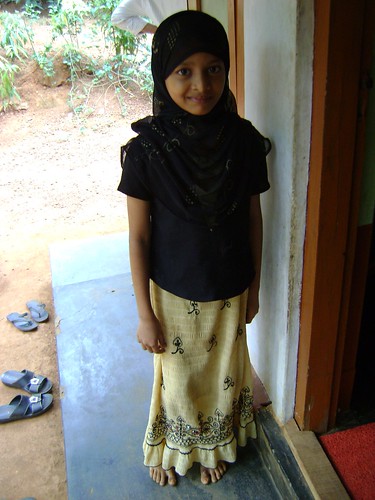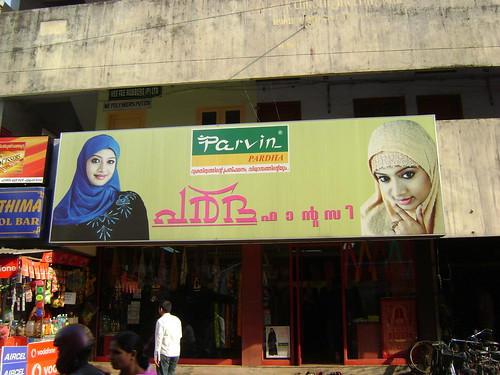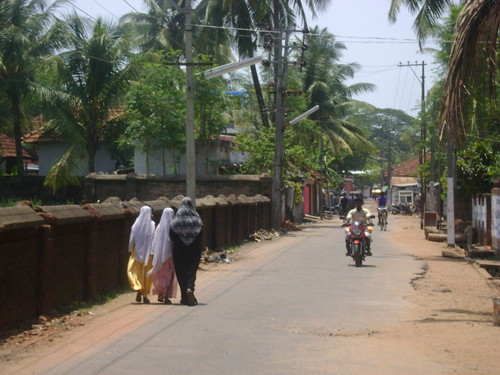By Najiya O., TwoCircles.net,
A few decades ago, if a Muslim woman from Malabar clad in a burqa had gone to Ernakulam, people would have looked at her astonished. Because, burqa or any such dress was unfamiliar in southern Kerala. But now, anyone can see women in burqa or girls wearing head-scarves walking through the busy streets of Ernakulam. Hijab is no more new in the work places, educational institutions and public functions in Kerala.
Salma of Kaloor, Ernakulam, tells us how it was to wear hijab at a time when no one wore it here. “I began wearing the hijab about 15 years ago, when I joined an Arabic College and learned Islam, its principles and the Holy Qur’an. That was in the late 1980s. No one in my place used to cover heads or wear full-sleeved blouses. When I adopted hijab, people began to mock at me. Every time I went out wearing the burqa, people would swarm around and call me names like ‘bear’.”

A Kerala Muslim girl in traditional clothes in Malappuram.
Salma recalls the first time when she returned home from hostel wearing a hijab. Her brother who was at the bus stop could not recognize her. She had to hold him by hand to make him understand.
That was in the past. Now burqa or head-scarf or any sort of hijab is not new to Ernakulam. Earlier only women coming from other places used to wear hijab. And the people of Ernakulam looked down upon them as traditional and anti-modern. Now the situation has changed altogether. Saliha and Assia are witness to this change.
Saliha and Assia are sisters. They hail from Coimbatore in Tamil Nadu. They came to Ernakulam around 30 years ago when their husbands came in search of jobs. They used to wear hijab in their native place. They wore purdah and head-scarf. But when they wore it in Ernakulam, people laughed at their dressing.
Saliha says, “People would come out of their houses and stand at the gates to see us walking wearing purdah. Children would run after us, pulling the end of scarf or shawl we wore. People would shout, ‘Look, crows are going!’ Then the street children would call out, ‘Crows! Crows!’ Then we stopped wearing purdah, and so we went out only very rarely.”
And now? Let’s go back to Saliha. “We began using the purdah permanently only about 15 years ago. By then,a sea-change had occurred in people’s attitude. Now you can see many people in the streets wearing burqa or any other sort of hijab. Earlier, only people who came from other districts wore hijab. Kochiites were always fashion-loving people. Kochi has really changed now. And now, burqa is fashionable.”

A shop in Cochin selling hijabs.
Indeed hijab is fashionable now. There are different types of burqas and head-scarfs. Now, women want to wear burqas of the most modern fashion. Many textile companies like the Hoorulyn are famous for their brand of burqas and head-scarves. They have different varieties and fashions of hijab. In these circumstances, won’t it be wise to look back to know how it was about fifty years ago?
Back to Malabar of the 1950s, and we can see only some women of Thangal (supposed to be of the lineage of Prophet p.b.u.h.) and moulvi families wearing the burqa which covered the whole body. Very few wore naqaab. They went out only at nights, that is, if they had to meet some of their relatives. Pitch dark night, black burqa, and above this they used black umbrellas too. They wore burqa mainly out of tradition. Their mothers and grandmothers had worn it, so they too. In other families, women wore dhoti (‘kachithuni’), full-sleeved loose blouse (‘penkuppayam’) and a shawl (‘thattam’). That was the sort of hijab they used. There was a minority which wore fashionable dresses. The educated few wore saris and matching blouses. They adopted the dressing style of the majority community, which was comparatively more educated.
In the 1960s, the women who wore burqa began to take it off. That was the age of communism in Kerala. Religion began to be considered anti-modern. The first communist government came to power in the state. Communism and atheism were rated high then.
In the 1970s, people began to go abroad in search of jobs. Many Muslims of Malabar went to the Gulf countries and saw the life style there. They saw women wearing hijab and going out in broad day light. Women wearing burqa were respected and admired there. When the men came back to Kerala, they brought dress materials from there for their wives and sisters. At first they brought a sort of turban that Arab women used to cover their heads. Then they brought head-scarf, and then gradually burqa. The burqa of the Arab countries was called as abaya by the people of Malabar. The online abaya was very loose and big. Then came the purdah, which was of medium size and more comfortable. Purdah became very popular among the Gulf families. Others too began to adopt it as it grew to be a symbol of status and fashion. When the men working in Arab countries took their families abroad, the women had to wear the burqa. They brought it back when they came to Kerala.

Hijab has become part of Kerala’s landscape
Earlier there were not many organisations among the Muslims in Kerala. The ones that functioned had no women’s wings or youth wings. When organisations began to sprout and women’s and youth wings became active, women found the hijab system of burqa, purdah and head-scarves comfortable. When these organisations opened educational institutions, they made purdah and scarves the uniform for girls. Thus purdah and scarves became very popular among people. The organisations also imparted religious education among people. They taught people the Holy Qur’an and the teachings of the Prophet. Translations of the Qur’an got published in Malayalam. This increased awareness of Islam also played its role in popularising hijab.
Mumtaz began to wear the purdah after she took to learning the Holy Qur’an. She recalls how her mother used to ask her to wear the dupatta/shawl covering the head when going out. But back then, when she was a young woman, she would not listen. However, she was interested in learning the Qur’an. Mumtaz says, “When I came to know that a teacher taught Qur’an in a nearby place, I joined the group of ladies there. I began to understand what is said in the Qur’an. Then I made a lot of changes in my life, including my dressing style. I began to wear the hijab. I have not taken it off since.”
Hafsa also began to dress the Islamic way after she attended religious classes. Those classes changed me, she said, I began to cover my head. Still, it was a revolution when she chose to wear full-sleeved blouses. Her husband who was a tailor said that he won’t stitch a full-sleeved blouse. So Hafsa had to go to another tailor. Hafsa and her co-sister wore full-sleeved blouses with sari for the wedding and that made a big talk then. Now Hafsa wears hijab always.
Hijab is now accepted by the people of Kerala. Earlier it was seen as a sign of oppression and people spoke against it due to superstitious beliefs. But now, the story of oppression has failed as more and more educated women are turning to the hijab. Still, there is opposition. But that comes out of fear. A fear of what would happen if women get to know and practice Islam well. The fear that traditional leaders have of the loss of their authority. However, women who wear the hijab feel safe, secure and confident. And that helps them to succeed.
[All photos: TwoCircles.net]
